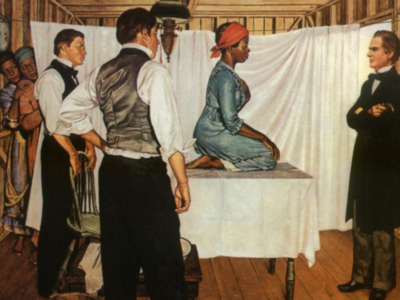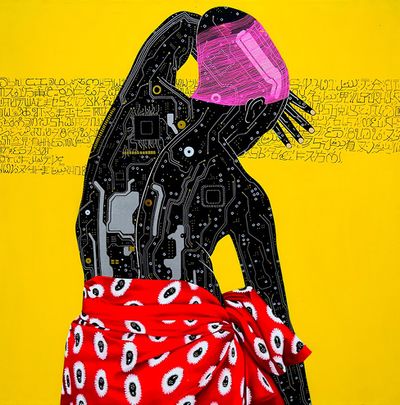History of Anarchaserver and Feminists Servers visit this section
Trigger Warning: This text and the accompanying images contain references to medical violence, slavery, and non-consensual experimentation. Reader discretion is advised.
Who was Anarcha?
The name of this server is inspired by research conducted in 2013 by Klau Kinki (Gynepunk) on the decolonization of the body. Her work led to our rediscovery of Anarcha’s story—one of the many hidden "herstories" of enslaved Black women.
Anarcha was an African American woman enslaved on the Wescott plantation near Montgomery, Alabama. When she went into labour, her delivery lasted three excruciating days. Dr. J. Marion Sims was called to assist. In his autobiography, he admits to using forceps on the fetus's head despite having little experience with the instrument. The fate of the baby is unknown, but Anarcha suffered severe vaginal tears during the birth and was left incontinent.
Soon after, her enslaver sent her to Sims in hopes he could "repair" the damage, as her condition lowered her value. Sims reluctantly took her in. While examining her—placing her on all fours and using a makeshift speculum fashioned from a pewter spoon—he unintentionally relieved the pressure misaligning her uterus, giving Anarcha immediate relief.
What followed was a prolonged period of non-consensual medical experimentation. With her enslaver’s permission, Anarcha became Sims’s test subject. She underwent dozens of surgeries while fully conscious, as anesthesia was withheld—based on the racist belief that Black people had a higher tolerance for pain. That belief was both widely accepted and entirely false.
Sims eventually repaired Anarcha’s condition, known as a vesicovaginal fistula. His experiments on her and two other enslaved women, Betsey and Lucy, contributed to the development of gynecological techniques and tools still in use today. Sims became known as the "father of modern gynecology," but his legacy is inseparable from the pain and exploitation of the women he used.
Anarcha was reportedly subjected to as many as 34 operations. She, Betsey, Lucy, and many unnamed others endured suffering so that Sims could advance his practice. They left no written records—the ability to read or write was forbidden to enslaved people and punishable by death.
Today, while medical history often regards Sims with ambiguity, there is no question about who the true mothers of modern gynecology were: Anarcha, Betsey, Lucy, and the countless enslaved Black women whose bodies were used without consent.
We remember them. And we say their names so they are never forgotten.
This 1952 painting by Robert Thom is the only known representation of Lucy, Anarcha and Betsey. Pearson Museum, Southern Illinois University School of Medicine
You can learn and read more about the story of those women in the websites related to:
Remembering Anarcha, Betsy, and Lucy, The True Mothers of Gynecology
Wellness directory of Minnesota
Marion Sims: Father Butcher by Wendy Brinker
A Note on the Scientific & Historical Context of BEHIND THE SHEET
Why a feminist server?
Feminist servers have long been a topic of discussion, a partially-realized goal, and a set of slow, political practices developed by an informal network of transfeminists. These efforts are rooted in the desire to create more autonomous infrastructures that ensure feminist data, projects, and collective memory are properly accessed, preserved, and managed.
The need for feminist servers arises in response to several intersecting issues: – the unethical practices of multinational ICT corporations that act as moralistic and hypocritical censors; – gender-based online violence, including trolling and the harassment of feminist and women activists both online and offline; – the increasing centralization of the internet, transforming it into a space of consumption, surveillance, and control—particularly targeting dissenting voices, often monitored or silenced by state agencies.
These conditions have made the internet an unsafe space. Feminist and activist content is routinely deleted, censored, or hidden—preventing it from being seen, heard, or read. In this context, freedom of expression becomes a key part of the feminist struggle. Transfeminists can contribute by collectively sharing the knowledge and tools needed to keep their voices accessible—online, offline, and across any format or space where expression may emerge.
A truly feminist internet requires self-managed and autonomous feminist servers. This is about reclaiming control and building autonomy in how we access, store, and manage our data and shared histories. It also means creating and sustaining feminist-run mailing lists, pads, wikis, content management systems, social platforms, and other online services managed by feminist tech collectives.
It is, of course, also about continuing to advocate for social justice in tech—demanding broader gender and cultural diversity in digital spaces and infrastructures.
To explore these goals, many sessions during the THF (TransHackFeminist convergence) focused on questions such as: – What is the purpose of a feminist server? – What makes a server autonomous and feminist? – What socially sustainable models exist for feminist server infrastructure? – How do we build trust and develop cooperative, collective approaches to managing these spaces of resistance and transformation?
And finally: What are our dreamed, embodied feminist technologies made of?
List of Feminist servers
The hertory of feminist servers does not start in 2014 as we know about previous initiatives that had similar intentions such as Samedies: Femmes et Logiciels libres started in 2006 in Bruxelles, or Birosca, another project for women and free software from Brasil. If you know about other initiatives of feminists servers please share with us!
The story we know about started in 2014 when two feminist servers projects were rebooted during the TransHackFeminist convergence in Calafou: the Systerserver project which was originally launched by Genderchangers and the Eclectic Tech Carnival and which focus on hosting online services; and Anarchaserver which was launched by Calafou inhabitants and people involved in the organisation of the THF! and focus on hosting living/dead/transitional data.
In 2015, friends located in Mexico launched an autonomous server that also provides support and hosting to feminist collectives, it is called Kefir. In 2016, a new feminist server was launched by members of the feminist hackerspace Marialab located in Sao Paolo (Brazil) called Vedetas. Finally, another syster initiative was set up in Brasil called Cl4ndestinas. To note also the collaborative project between Kefir, Periféricas e Vedetas (México, Salvador e São Paulo) focused in setting up Redes Autonomas Feministas (Autonomous Feminist Networks) set up in 2016.
Since then more and more feminist infrastructure initiatives came along, you can check some of their services in this section.
Please note that we do not keep track of new feminist servers initiatives since 2023.
Reading and listening
- 2023: Trajectoires des hacklabs, biolabs, fablabs féministes en France Une table ronde modérée par spideralex avec Le reset (Anne), Hackstub / collectif cyberféministe Hacqueen (Mj, Cécile), Portes logiques (Laure), BIB transféministe (K2, Calam, Mare), FluidSpace (Chloé, Lorca, Célia), La fun (Catherine) et Peggy Supergeante (Samedies femmes et logiciels libres)
- 2022: Encounters, coffees and conflicts: Reflections from action-research on a feminist autonomous network
- 2022: Feminist by Design With contributions from Nyx McLean, Nadege, Débora Prado, Aayush Rathi, Horacio F. Sívori, Akash Sheshadri, Ambika Tandon, Bruna Zanolli and Bruno Zilli. Edited by Mariana Fossatti, Tigist Shewarega Hussen and Namita Aavriti Malhotra, and conceptualised with Nishant Shah professor of Aesthetics and Cultures of Technologies at ArtEZ University of the Arts. The editorial team would like to thank all the authors and peer reviewers for their time and efforts on behalf of this special issue on Feminist by Design. Download the print issue here
- 2021: Episode 3 - Auto-Hostings (A Primordial Coup without Causing Injury) for "Nodes of ∏node" A show specially made by the ∏node collective for the Planet Orsimanirana voyager sonic UFO. It is a non exhaustive tour of the initiatives, works, projects and sounds around the ∏node community
- 2021: Revue Mouvements - FR: Infrafem, Ressources et répertoires féministes WIP
- 2020: FEMINISTS ARE BUILDING THEIR OWN TECHNOLOGY TO ORGANISE BUT WHERE ARE FUNDERS? by Ledys San Juan
- 2020: CAST:Por debajo y por los lados: sostener infraestructuras feministas con ficción especulativa
- 2019: Nos permitimos imaginar: escrituras hackfeministas para otras tecnologías Esta publicación compartimos los materiales creados por quienes participamos del Encuentro hackfeminista tecnología y afectos: ¿Cómo bosquejar políticas de la co-responsabilidad? de 2019 organizado en colaboración con Sursiendo, Instituto de Liderazgo Simone de Beauvoir y Tecnológico de Monterrey.
- 2018: Interview with spideralex in Panthere Premiere, issue n°4, on feminists servers. You can download the interview in french here:
File:Pantheres 4 serveursfeministes.pdf Online version of the article
- 2018: Cornelia Solfrank with spideralex and Femke snelting about feminist servers
- 2018: Interview with spideralex in Neural n°61, special issue on Cyberfeminism, will share next months the pdf
- 2018: Lili_Anaz y Natasha Akhmatova develop this precious manifesto for hackfeminist algorhytmns in Spanish - MANIFIESTO POR ALGORITMIAS HACKFEMINISTAS
- 2017: Friends from radio program El desarmador realised a nice program about self managed servers that discuss also the need for feminist servers, you can listen to it here and you can read their article here.
- 2017: By Nadege an article about Feminist autonomous infrastructure in the internet battlefield: From Zombies to Ninjas
and also Necesitamos interfaces que nos hagan libres - We need interfaces that makes us free
- 2017: By Nanda (Vedetas) and Nadege (Kefir) a manifesto called #From steel to skin available in different languages:
- 2016: Article in Spanish by Anamhoo entitled Infraestructura para una revolución violeta published in the boletin antivigilancia.
- 2016: Article entitled QueerOS: A User’s Manual by fiona barnett, zach blas, micha cardenas, jacob gaboury, jessica marie johnson, margaret rhee
- 2015: The need for feminist servers by Sophie Toupin and spideralex available in Feminist autonomous infrastructures developed for the Global Information Society Watch 2015 focused on sexual rights and the internet.
- 2013: Notes taken during the Feminist Server Summit [2] hosted by Constant In Brussels in December 2013. Other links about the "Are you being served?" 2013 event can be found here and here. The book about the event can be downloaded here.
- We specially like this proposal from Femke about what could be a Feminist Server
A feminist server ...
Is a situated technology. Her sense of context results from a federation of competences;
Is run for and by a community that cares enough for her in order to make her exist;
Has an awareness of the materiality of software, hardware and the bodies gathered around it;
Treats network technology as part of a social reality;
Is able to scale up or down, and change processing speed whenever resources require;
At the risk of exposing her own insecurity, opens up processes, tools, sources, habits, patterns;
Does not strive for seamlessness. Talk of transparency too often signals that something needs to be made invisible;
Radically questions the conditions for serving and service; experiments with changing client – server relations where she can;
Avoids efficiency, ease-of-use and reliability because they can be traps Knows that networking is actually a parasitic, promiscuous and often awkward practice;
Is autonomous in the sense that she tries to decide for her own dependencies Takes control because she wants networks to be mutable and read-write accessible;
Faces her freedom with determination. Vulnerability is not an alibi;
Is a paranodal (we did not mean: paranoid) technology. A feminist server is both inside and outside the network;
Does not confuse a sense of false security with providing a safe place; Tries hard not to apologise when she is sometimes not available.
Image by Eddy Kamuanga Ilunga

